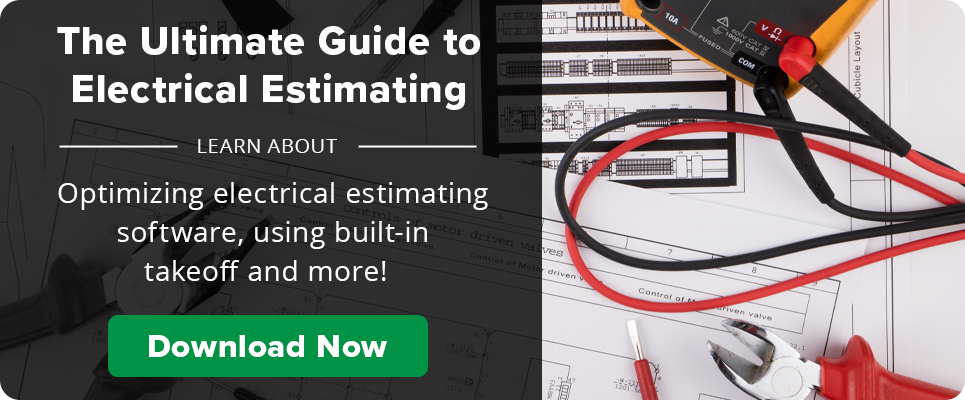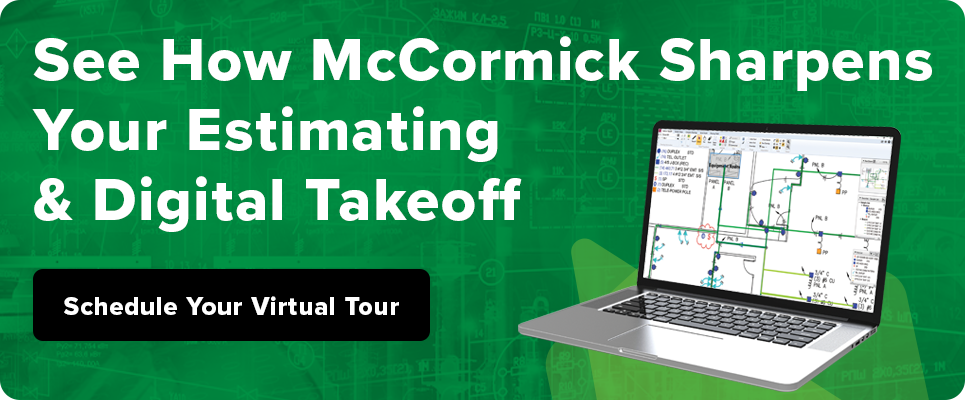
by Paul Wheaton
April 5, 2023
Low-voltage wiring refers to electrical wiring that carries less than 50 volts. In commercial construction, projects requiring low-voltage wiring involve low-power devices such as security cameras, intercoms, thermostats, and other electronic systems.
Low-voltage wiring is typically installed during the initial stages of construction and is often referred to as “structured wiring.” It includes various components such as cables, connectors, outlets, and distribution panels, which are designed to distribute low-voltage power and data throughout the building. Many contracting companies use low-voltage estimating software to create faster cable runs and easily count data outlets.
What Is Low-Voltage Wiring?
Most wall outlets are 120V to 240V, while low-voltage wiring is less than 50. Small appliances require a higher voltage, but communication and network equipment generally need lower volts to operate.
Low-voltage wiring uses a structured cabling infrastructure and has become essential to the functioning of many modern buildings. It’s usually installed by certified professionals with the training and expertise to ensure the wiring is safe and complies with local building codes and regulations.
Structured cabling is a type of infrastructure that involves the installation of standardized cabling systems, which provide a reliable and organized way to transmit data and signals. Structured cabling infrastructure typically includes a centralized patch panel or distribution point, enabling various devices to connect to the network.
Low-voltage wiring and structured cabling have become essential to the functioning of modern buildings, as they enable the reliable transmission of data and signals that are critical to various building systems. With these systems, many modern buildings could function efficiently and effectively.
Types Of Low-Voltage Wiring
An important aspect of commercial construction, some common types of low-voltage wiring include:
Structured cabling: This type of low-voltage wiring is used for data and communication networks. It includes Ethernet and fiber optic cables that transmit data between computers, servers, and other network devices.
Security wiring: This includes wiring for security cameras, motion sensors, access control systems, and alarm systems. This type of wiring is essential for ensuring the safety and security of the building and its occupants.
Audio/visual wiring: This type of wiring is used for audio and video systems, including sound systems, video conferencing systems, and digital signage displays. It is commonly used in conference rooms, auditoriums, and other public spaces.
Fire alarm wiring: Fire alarm systems require low-voltage wiring to connect smoke detectors, heat detectors, and other fire alarm components to the main control panel. This wiring is critical for protecting the building and its occupants in the event of a fire.
HVAC control wiring: Low voltage wiring connects HVAC equipment to the building’s control system. This includes wiring for thermostats, sensors, and control panels that manage heating, ventilation, and air conditioning systems.
Applications Of Low Voltage Wiring
Due to the fragile nature of low-voltage wiring, it is only used for specific applications. These are:
WiFi: Any present-day construction project requires WiFi. Stores, office buildings, medical facilities, schools, malls, hotels, and warehouses could not function without WiFi.
CCTV Cameras: For surveillance, CCTV cameras are widely used in retail, commercial, and industrial spaces. This includes monitors, digital recorders, and cameras.
Telephones: Most commercial buildings include voice-over-IP telephone systems. Complete with multiple lines, hold, and transfer options, telephones need specific wiring to provide the connection required.
Security Systems: Many companies use a security system to allow only approved employees and visitors into their buildings. Card readers or biometric scanners ensure that authorized personnel only access certain areas.
Audio-Visual Wiring: This is often part of the work being done by the company, is a marketing or training tool, or is utilized in meeting rooms, showrooms, bars, restaurants, or salons to provide entertainment or education.
Fire Safety: Fire alarms and fire suppression systems are often required in commercial spaces to prevent and protect employees and customers.
Intercom or Paging: Hospitals, nursing homes, warehouses, big box stores, and car showrooms often use intercoms or paging systems to communicate in larger spaces.
Scope Of Low Voltage Wiring Applications
Low-voltage wiring is used for a variety of applications in all areas of construction in three specific categories.
Residential – Doorbells, garage door openers, landscape lighting, network cable, thermostats, automation systems, security, and telephone lines.
Commercial – Cable, telephone lines, virtual communication, security cameras and monitors, fire alarm and suppression systems, particularly in commercial establishments with a kitchen area, intercom and paging, and WiFi.
Industrial – Similar to commercial applications but may include card readers or biometric scanners to allow only authorized personnel into certain building areas.
The Benefits of Using McCormick’s Estimating Software for Low Voltage Wiring
Low-voltage estimating software helps create accurate estimates. With McCormick Systems’ industry-specific software, users receive access to a pre-loaded database of electrical elements and assemblies. This makes the process efficient and professional. McCormick Systems’ takes you from takeoff to estimate with much less effort than doing it manually:
Upload Circuit Blueprints – McCormick’s patented Home Run technology measures and calculates materials, costs, and the prime pathway for maximum efficiency.
Upload Quantity Of Materials – With McCormick Systems’ pre-built items and assemblies database, no counting is needed as the system automatically does it for you.
Material Prices – Up-to-date pricing is available in real-time from preferred suppliers.
Labor Costs – Automatically calculate estimates as you build for labor and material cost
Multi-user platform – McCormick System for low-voltage contractors allows the team to see real-time changes and updates.
Integrated takeoff and estimating – Eliminate errors and complete your bid quicker and more effectively.
Why McCormick Systems?
McCormick Systems offers two levels of software designed specifically for low-voltage estimating: McCormick and McCormick Pro. Contractors can choose the program that meets their needs and stays within their budget. With online classes, location-based education, and on-site interactive training, learning our system is expedited in your time frame.
Our Low Voltage Estimating Software can help contractors provide faster bids and win more jobs. Additionally, McCormick is backed by 40 years of construction estimating experience. You can rest assured we work alongside you to provide the best in the business!
Share Article


